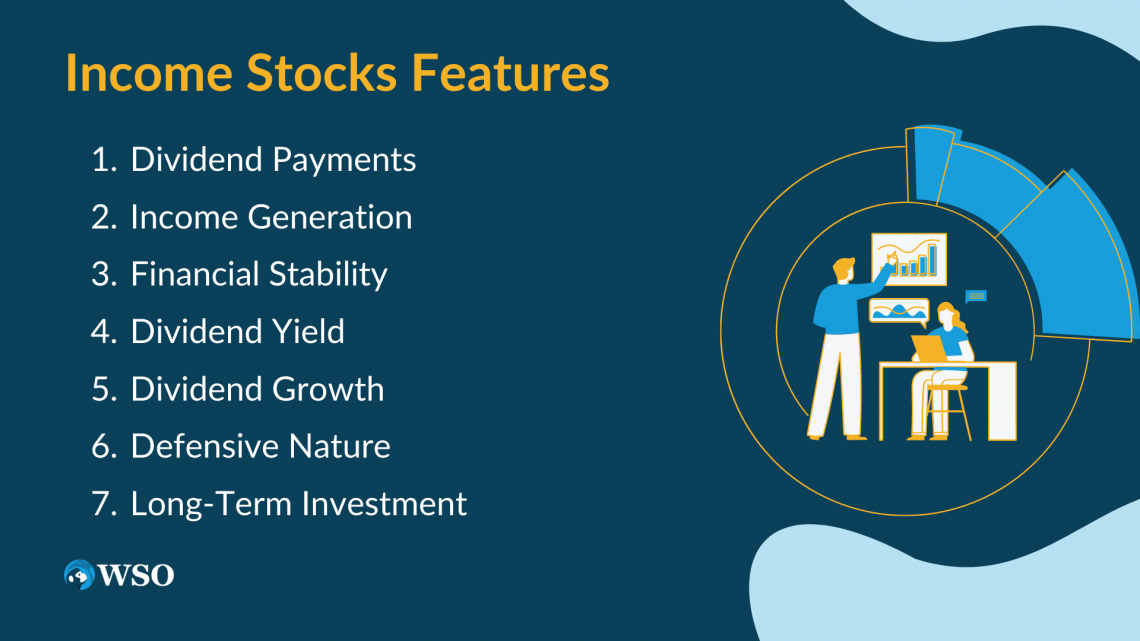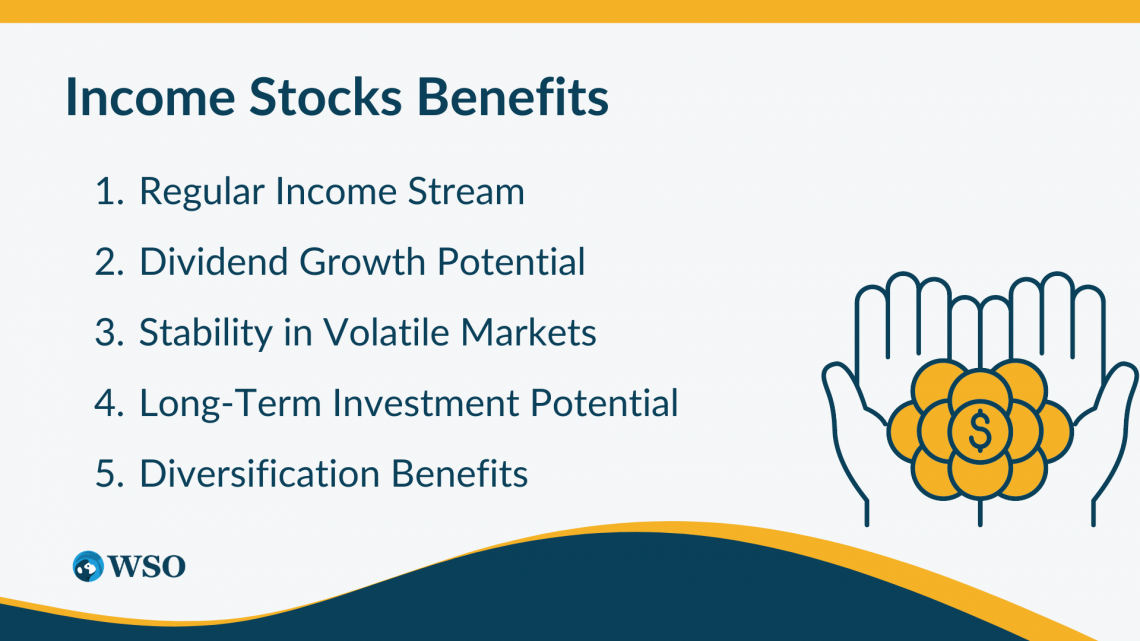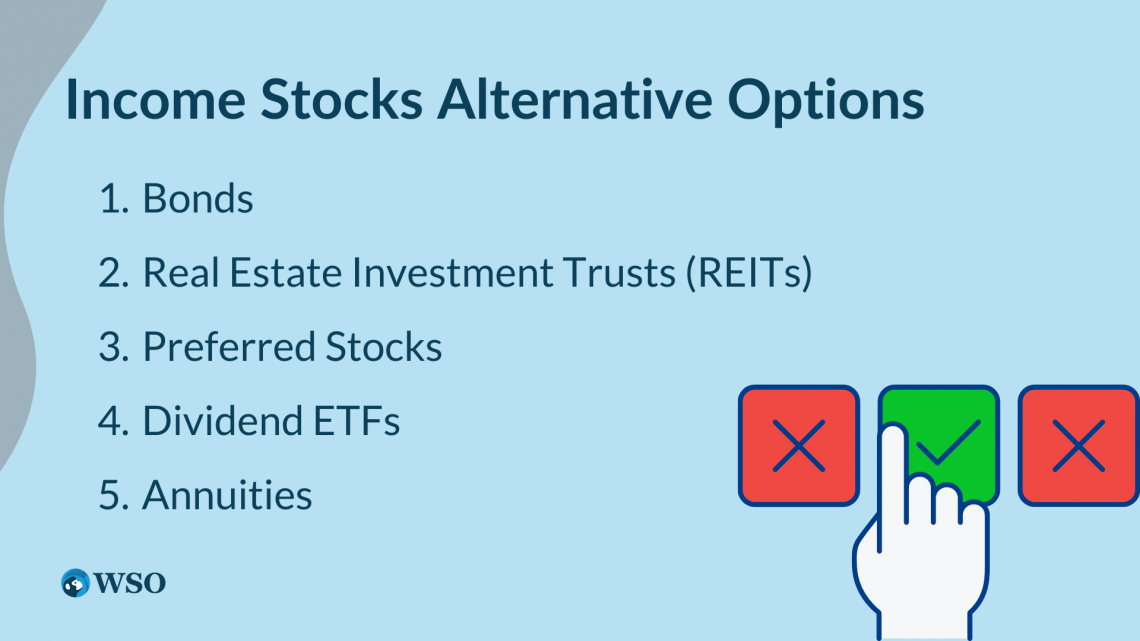Income Stocks
Shares of stable, dividend-paying companies chosen for steady income; usually mature businesses with lower growth potential.
Income stocks are stocks that provide investors with a consistent revenue stream over time and are generally associated with low levels of risk. The money can be received in dividends or just on the earnings alone.

Income stocks produce a relatively stable income stream for investors. They can use this income to cover their expenses or reinvest it to buy more shares. They are generally associated with companies in mature industries with stable market presence.
These companies often generate consistent earnings and have a history of paying dividends even during economic downturns. Examples of industries that commonly feature income stocks include utilities, consumer staples, telecommunications, and healthcare.
An income stock pays a relatively reliable dividend, a portion of the company's profits, to its shareholders. Dividend payments are disbursements, typically in cash, that some companies regularly send to their investors.

Most companies pay quarterly dividends, although some provide income only annually or semi-annually. A few companies pay monthly dividends, making them ideal income stocks. Investors earn a dividend yield, the total annual dividend payments divided by its stock price.
Investing in these stocks can appeal to individuals seeking regular cash flow or supplement their existing income. Retirees or those approaching retirement often find these stocks attractive because they provide a reliable income stream without requiring them to sell shares of stock.
Key Takeaways
- Income stocks are associated with companies that pay consistent dividends.
- They typically belong to mature, stable companies in established industries.
- They prioritize cash flow and focus on stability rather than rapid growth.
- Common sectors for these stocks include utilities, telecommunications, REITs, consumer staples, and healthcare.
- The dividend yield is an important metric for these stocks.
- Investors seek companies with a track record of maintaining or increasing dividend payments.
- They can provide a regular income stream but may offer lower capital appreciation potential compared to growth stocks.
Income Stocks Features
Income stocks belong to companies that are financially strong, well-established, and have a constant record of paying dividends. Here are some key features:

1. Dividend Payments
The primary feature of these stocks is their regular dividend payments. These stocks often represent businesses that produce steady and predictable cash flows, enabling them to pay dividends to shareholders as a fraction of their earnings.
Although some businesses may pay dividends monthly or annually, they are typically distributed at three-month intervals.
2. Income Generation
These stocks are popular among investors seeking a regular income stream. Retirees or individuals looking for passive income often invest in these stocks to supplement their earnings.
Note
The dividends received can be used to cover living expenses, reinvested to compound returns, or redirected to other investment opportunities.
3. Financial Stability
Companies that issue income stocks are well-established, financially sound, and have a proven track record of profitability.
They typically operate in mature industries with steady product or service demand. These companies prioritize maintaining stable operations and consistent cash flows, which supports their ability to sustain dividend payments over time.
4. Dividend Yield
The dividend yield is a crucial metric for these stocks. It represents the dividend payment as a percentage of the stock price. A higher dividend yield indicates a higher return on investment in the form of dividends.
Note
It's important to consider other factors like the company's financial health, dividend sustainability, and yield.
5. Dividend Growth
While these stocks are known for their regular dividend payments, many successful companies also strive to increase their dividends over time.
Dividend growth indicates that a company's earnings are growing, demonstrating a commitment to rewarding shareholders. Investors often seek companies with a history of consistent dividend growth.
6. Defensive Nature
They are considered more defensive investments compared to growth stocks. During market downturns or economic uncertainties, these stocks tend to be less volatile, providing investors with relative stability and a regular income stream.
Note
This defensive nature can act as a hedge against more volatile investments in a well-diversified portfolio.
7. Long-Term Investment
They are typically favored by long-term investors. Their regular income and the potential for dividend growth and capital appreciation can lead to attractive total returns over time. Patient investors prioritizing income generation and stability hold these stocks for an extended period.
Income Stocks Benefits
Understanding these aspects is crucial for making informed investment decisions. Here are some potential benefits and risks associated with income stocks:

1. Regular Income Stream
They provide a reliable and regular income stream through dividend payments. This feature makes them attractive to investors seeking a consistent source of income, such as retirees or those looking for passive income.
2. Dividend Growth Potential
Some of them have a track record of increasing their dividends over time. Dividend growth indicates a company's financial strength and can provide investors with increased income in the future.
Note
Companies that consistently raise their dividends demonstrate a commitment to shareholder value.
3. Stability in Volatile Markets
They are often considered defensive investments. They tend to be less volatile than growth stocks, providing investors with stability during market downturns or economic uncertainties. This stability can act as a hedge against more volatile investments in a well-diversified portfolio.
4. Long-Term Investment Potential
They can generate attractive total returns over the long term. Combining regular income through dividends and the potential for capital appreciation can contribute to wealth accumulation for patient, long-term investors.
5. Diversification Benefits
Including income stocks in a diversified investment portfolio can provide diversification benefits.
Note
Investing in stocks from different sectors and industries can spread their risk and reduce exposure to specific market fluctuations.
Income Stocks Risks
Different risks affecting income stocks are:

1. Dividend Reduction or Suspension
Businesses may decide to cut back on or stop paying dividends for several reasons, including financial hardship, bad economic times, or business decisions. This can negatively impact investors relying on dividend income and may lead to a decline in the stock's value.
2. Market and Sector Risks
They are still subject to market risks and fluctuations. Economic conditions, industry-specific challenges, or changes in consumer preferences can affect the financial performance of the companies issuing these stocks.
They can be sensitive to changes in interest rates. The demand for income equities may decline if fixed-income investments become more appealing as interest rates increase. This can put downward pressure on stock prices.
4. Limited Growth Potential
While these stocks provide regular income, their capital appreciation potential may be relatively lower compared to growth stocks.
Note
Income stocks often belong to mature companies in established industries, which may limit their ability to deliver significant capital gains.
5. Company-Specific Risks
Each income stock carries its company-specific risks. These may include elements that affect the company's financial performance and, consequently, its capacity to continue paying dividends, such as management changes, competitive pressures, governmental restrictions, or technological upheavals.
Income stocks Vs Growth stocks
Income and growth stocks are two different types of investments that appeal to different types of investors. While both offer unique characteristics and potential advantages, they differ in terms of their focus on generating income versus capital appreciation.

Here's a comparison of income and growth stocks:
| Income Stocks | Growth Stocks | |
|---|---|---|
| Objective | Generate regular income through dividend payments. | Achieve capital appreciation through stock price growth. |
| Focus | Stable and established companies with consistent cash flows. | High-growth companies with high potential to grow. |
| Dividend Payments | Regular dividend payments as a source of income. | Minimum or no dividend payments, reinvesting in growth. |
| Dividend Yields | Higher dividend yield | Lower dividend yield |
| Risk Profile |
Lower volatility and potential for downward protection. |
Higher volatility and potential for greater returns. |
| Financial Stability | Financial stable and mature companies. | Early-stage or high-growth companies with greater risk. |
| Investment Horizon | More suitable for long-term investors seeking income. | More suitable for investors seeking capital appreciation. |
| Diversification | It can provide stability and income components in a diversified portfolio. | It may offer growth potential to complement other investments. |
| Examples | Utility companies, consumer staples, and real estate investment trusts (REITs). | Technology companies, biotech startups, and emerging industries. |
Income Stocks Alternative Options
There are alternatives available for individuals trying to diversify their investment portfolio or investigate various income-generating tactics, even though these stocks might be a popular choice for those seeking consistent income.

Here are some alternative options:
1. Bonds
Bonds are debt securities issued by governments, municipalities, and corporations. They offer fixed interest payments, known as coupon payments, to investors.
Bonds can also provide a steady income stream, and their risk profile varies based on the issuer and credit rating. Treasury bonds, municipal bonds, and corporate bonds are common options to consider.
2. Real estate investment trusts (REITs)
They provide income from real estate and hold and manage properties by businesses. Without owning real estate directly, investing in REITs enables people to obtain exposure to the industry.
Note
REITs generate income through rental income from properties and often distribute a significant portion of their earnings as dividends to shareholders.
3. Preferred Stocks
These stocks combine features of both stocks and bonds. They offer fixed dividend payments to shareholders, similar to bond coupons, but with higher priority over common stock dividends.
Preferred stocks provide a steady income stream and may have less volatility compared to common stocks. However, they generally have limited upside potential for capital appreciation.
Dividend-focused exchange-traded funds (ETFs) invest in a diversified portfolio of dividend-paying stocks.
Note
These funds invest in a basket of dividend-paying stocks, offering exposure to various sectors and companies. Dividend ETFs can provide a convenient way to gain broad dividend income exposure without the need for individual stock selection.
5. Annuities
Annuities are financial products offered by insurance companies that provide a regular income stream over a specified period or for life.
Investors provide the insurance firm with a one-time payment or recurring premiums, which are then reimbursed to them regularly. Annuities can be tailored to fit specific income needs and risk preferences.
Conclusion
Income stocks can be an attractive investment option for investors seeking regular income and portfolio stability. They have many advantages, including dividend growth over time, stability in volatility, and potential for long-term investment profits.

They also provide a consistent income stream through regular dividend payments. They are often associated with financially stable and mature companies operating in established industries.
It's important for investors to carefully analyze the specific income stocks they are considering and assess their financial health, dividend history, industry trends, and overall market conditions before making investment decisions.
However, it's important to consider the potential risks associated with these stocks. Factors impacting the performance of income stocks are:
- Dividend reduction or suspension
- Market and sector risks
- Interest rate sensitivity
- Limited growth potential compared to growth stocks
- Company-specific risks

Bonds, REITs, preferred stocks, dividend ETFs, high-yield bonds, peer-to-peer lending, and annuities are the various income-generating possibilities to diversify investment portfolios. Each of these alternatives offers different risk-return profiles and can provide diversification benefits.
Ultimately, the suitability of these stocks will depend on an investor's specific financial goals, risk tolerance, and investment strategy.
Seeking guidance from a financial advisor and conducting thorough research is essential to make informed decisions and building a well-balanced portfolio that aligns with individual objectives.









or Want to Sign up with your social account?